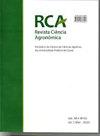Adaptation, calibration, and validation of the agro-ecological zone model for Urochloa humidicola pastures1
IF 1
4区 农林科学
Q3 AGRICULTURE, MULTIDISCIPLINARY
引用次数: 0
Abstract
- The agro-ecological zone model (AZM-FAO) is used to describe agricultural scenarios and the impact of climate risk on crops and, when adapted, can be used to simulate the yield of forage species under adverse conditions. The study aimed to test the performance of the AZM-FAO model to simulate the yield of Urochloa humidicola grass in Mato Grosso. The model was adapted for two locations with different soil and climate conditions, with data from two experiments (E1 and E2). The morphophysiological variables of the pastures, the physical-hydric variables of the soil, and the meteorological data of the experimental period were analyzed. The model calibration was based on changes in the yield response coef fi cient to water (Ky) and the minimization of deviations between simulated and observed data. The model presented a satisfactory performance for the two analyzed locations. In experiment E1, the RMSE was 29.86% (acceptable), and the c index was 0.86 (optimal) in the calibration phase, maintaining the same results in the validation. In E2, there was an improvement in the performance of the model, with RMSE and c index going from 30.74% (poor) and 0.84 (very good) in the calibration to 17.50% (good) and 0.92 (very good) in the validation step, respectively. The AZM-FAO model adapted for Urochloa humidicola grass can be used with good accuracy to simulate the forage yield of this forage in the southern region of Mato Grosso草地农业生态区模型的适应、标定与验证[j]
本文章由计算机程序翻译,如有差异,请以英文原文为准。
求助全文
约1分钟内获得全文
求助全文
来源期刊

Revista Ciencia Agronomica
Agricultural and Biological Sciences-Horticulture
CiteScore
2.00
自引率
0.00%
发文量
41
审稿时长
4-8 weeks
期刊介绍:
To publish technical-scientific articles and study cases (original projects) that are not submitted to other journals, involving new researches and technologies in fields related to Agrarian Sciences. Articles concerning routine analysis, preliminary studies, technical notes and those which merely report laboratorial analysis employing traditional methodology will not be accepted for publication. The Journal of Agronomical Science also has the mission to promote the exchange of experience in the referred fields.
 求助内容:
求助内容: 应助结果提醒方式:
应助结果提醒方式:


